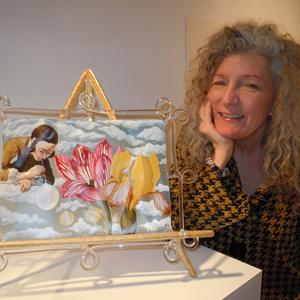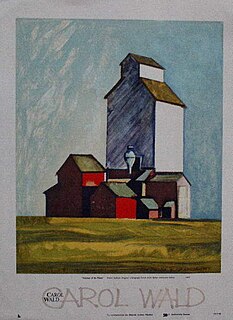
The Cranbrook Educational Community is an education, research, and public museum complex in Bloomfield Hills, Michigan. This National Historic Landmark was founded in the early 20th century by newspaper mogul George Gough Booth. It consists of Cranbrook Schools, Cranbrook Academy of Art, Cranbrook Art Museum, Cranbrook Institute of Science, and Cranbrook House and Gardens. The founders also built Christ Church Cranbrook as a focal point in order to serve the educational complex. However, the church is a separate entity under the Episcopal Diocese of Michigan. The sprawling 319-acre (1,290,000 m2) campus began as a 174-acre (700,000 m2) farm, purchased in 1904. The organization takes its name from Cranbrook, England, the birthplace of the founder's father.
Patricia Lynne Duffy is the author of Blue Cats and Chartreuse Kittens: How Synesthetes Color Their Worlds, the first book by a synesthete about synesthesia. 'Blue Cats' has been reviewed in both the popular press as well as in academic journals, Cerebrum and the APA Review of Books. The book describes Duffy's own experience of synesthesia, as well as that of the many synesthetes she interviewed, along with theories of what causes synesthetic perception.

Ginny Ruffner is a pioneering American glass artist based in Seattle, Washington. She is known for her use of the lampworking technique and for her use of borosilicate glass in her painted glass sculptures.

Ida Rittenberg Kohlmeyer was an American painter and sculptor who lived and worked in Louisiana. Kohlmeyer took up painting in her 30s and achieved wide recognition for her work in art museums and galleries throughout the United States. Notably, her work is held by the National Museum of Women in the Arts, the Smithsonian American Art Museum, the Ogden Museum of Southern Art and the New Orleans Museum of Art. Ms. Kohlmeyer, a member of the Reform Jewish movement, played an active role in the New Orleans Jewish community throughout her life. Touro Synagogue displays much of her artwork in their synagogue and in the social hall.
Toshiko Takaezu was an American ceramic artist, painter, sculptor, and educator who was known for her rounded, closed forms that viewed ceramics as a fine art and more than a functional vessel. She is of Japanese descent and from Pepeeko, Hawaii.
The American Synesthesia Association (ASA) is a not-for-profit academic and public society whose mission is to foster and promote the education and the advancement of knowledge of the phenomena of synesthesia, a neurological condition in which stimulation in one sensory modality leads to experiences in a second, unstimulated modality. The ASA attempts to promote and provide a means for the people who experience and/or study synesthesia to be in contact with each other. As part of its educational mission, the ASA provides information to scientists, health professionals, academicians, researchers, artists, writers, musicians, lay persons and people who experience synesthesia.
The phrase synesthesia in art has historically referred to a wide variety of artists' experiments that have explored the co-operation of the senses in the genres of visual music, music visualization, audiovisual art, abstract film, and intermedia. The age-old artistic views on synesthesia have some overlap with the current neuroscientific view on neurological synesthesia, but also some major differences, e.g. in the contexts of investigations, types of synesthesia selected, and definitions. While in neuroscientific studies synesthesia is defined as the elicitation of perceptual experiences in the absence of the normal sensory stimulation, in the arts the concept of synaesthesia is more often defined as the simultaneous perception of two or more stimuli as one gestalt experience. The usage of the term synesthesia in art should, therefore, be differentiated from neurological synesthesia in scientific research. Synesthesia is by no means unique to artists or musicians. Only in the last decades have scientific methods become available to assess synesthesia in persons. For synesthesia in artists before that time one has to interpret (auto)biographical information. For instance, there has been debate on the neurological synesthesia of historical artists like Kandinsky and Scriabin. Additionally, Synesthetic art may refer to either art created by synesthetes or art created to elicit synesthetic experience in the general audience.

Carol S. Wald was an American artist who was also widely known for her talents as an illustrator. Her collages and paintings appeared in Time, Fortune, and Ms, and on the covers of Business Week, the New York Times Sunday Magazine, and Saturday Review.

Synesthesia or synaesthesia is a perceptual phenomenon in which stimulation of one sensory or cognitive pathway leads to involuntary experiences in a second sensory or cognitive pathway. People who report a lifelong history of such experiences are known as synesthetes. Awareness of synesthetic perceptions varies from person to person. In one common form of synesthesia, known as grapheme–color synesthesia or color–graphemic synesthesia, letters or numbers are perceived as inherently colored. In spatial-sequence, or number form synesthesia, numbers, months of the year, or days of the week elicit precise locations in space, or may appear as a three-dimensional map. Synesthetic associations can occur in any combination and any number of senses or cognitive pathways.

Maija (Majlis) Grotell was an influential Finnish-American ceramic artist and educator. She is often described as the "Mother of American Ceramics."
Kate Clark is a New York-based sculptor, residing and working in Brooklyn. Her work synthesizes human faces with the bodies of animals, the signature component in all of her work. These sculptures study the tension between personal and mythical realms, and draw a fine line between the characteristics of animals and humans. Kate's preferred medium is actual animal hide. Mary Logan Barmeyer says Clark's work is "meant to make you think twice about what it means to be human, and furthermore, what it means to be animal." Writer Monica Ramirez-Montagut says Clark's works "reclaim storytelling and vintage techniques as strategies to address contemporary discourses on welfare, the environment, and female struggles."

William Mozart McVey was an American sculptor, animalier and teacher.
Harriete Estel Berman is an American artist known for her sculptures and jewelry made from post-consumer, recycled household goods, and her satirical explorations of women's roles in society.
Brenda Goodman is an artist and painter currently living and working in Pine Hill, New York. Her artistic practice includes paintings, works on paper, and sculptures.
Shiva Ahmadi is an Iranian-American artist known for her paintings, videos and installations, which have been exhibited at galleries and museums in North America and the Middle East.
John Parker Glick was an American ceramicist. Though open to artistic experimentation, Glick was most influenced by the styles and aesthetics of Asian pottery—an inspiration that shows in his use of decorative patterns and glaze choices. His experience working with ceramics led him to publish several articles about the craft. In addition to producing pottery, Glick began making "landscape oriented" wall panels during the latter part of his career. Known as "the people's potter," he is primarily remembered for his contributions to art and the field of ceramics.

Loja Saarinen (1879-1968) was a Finnish-American textile artist and sculptor who founded the weaving department at the Cranbrook Academy of Art in Michigan. She also led her own studio, the Studio Loja Saarinen, which designed many of the textiles used in buildings designed by her husband, the architect Eliel Saarinen.
Maya Stovall is an American conceptual artist and anthropologist. Stovall is best known for her use of ballet and public space in her art practice. She is an assistant professor at California State Polytechnic University, Pomona and lives and works in Detroit and LA County.
Joan Livingstone is an American contemporary artist, educator, curator, and author based in Chicago. She creates sculptural objects, installations, prints, and collages that reference the human body and bodily experience.








